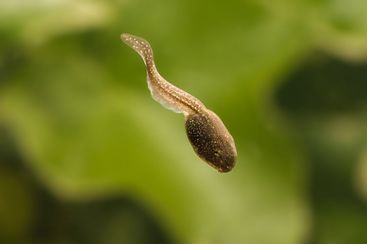ranchosantafenow.net – Tadpoles are the larval stage of frogs and toads (collectively known as anurans). These aquatic creatures represent the first phase of a complex life cycle involving metamorphosis, a dramatic transformation that prepares them for a terrestrial or semi-aquatic adult life. Tadpoles are fascinating in their own right, exhibiting a range of adaptations for aquatic existence.
What is a Tadpole? Defining the Larval Stage
A tadpole is the aquatic larva of an anuran. They are distinctly different in appearance from adult frogs or toads, possessing several key characteristics:
- Oval or Elongated Body: Tadpoles typically have an oval or elongated body shape, streamlined for swimming.
- Tail: A prominent tail is the primary means of propulsion in the water. The tail is usually flattened laterally (side to side).
- External Gills (Early Stages): In the early stages of development, tadpoles have external gills for breathing underwater. These gills are often feathery in appearance.
- Internal Gills (Later Stages): As they develop, the external gills are typically replaced by internal gills, which are protected by a flap of skin called the operculum.
- Mouth and Beak: Tadpoles have a specialized mouth with horny beak-like structures used for scraping algae and other food from surfaces.
- Lack of Limbs (Initially): Initially, tadpoles lack limbs. Hind limbs develop first, followed by front limbs.
The Tadpole Life Cycle: From Egg to Metamorphosis
The tadpole stage is part of a larger life cycle that includes:
- Egg: Anuran eggs are laid in water, often in gelatinous masses known as spawn.
- Hatching: Tadpoles hatch from the eggs and begin their aquatic life.
- Growth and Development: Tadpoles undergo a period of growth and development, during which they increase in size and develop various anatomical features.
- Metamorphosis: Metamorphosis is the dramatic transformation from tadpole to froglet (young frog). This process involves significant changes in anatomy, physiology, and behavior.
Tadpole Habitats: Thriving in Aquatic Environments
Tadpoles are found in a variety of aquatic habitats:
- Ponds and Lakes: These still-water environments provide ideal habitat for many tadpole species.
- Streams and Rivers: Some tadpole species are adapted to flowing water environments.
- Temporary Pools and Wetlands: These ephemeral habitats can also support tadpole development.
Tadpole Diet: Primarily Herbivores
Most tadpoles are primarily herbivorous, feeding on:
- Algae: Algae are a major food source for many tadpole species.
- Plant Matter: They also consume other aquatic plants and decaying organic matter.
- Filter Feeding: Some tadpole species are filter feeders, straining small particles from the water.
- Carnivorous Tadpoles: Some species are carnivorous, feeding on insects, other tadpoles, or even small fish.
Tadpole Behavior: Adaptations for Aquatic Life
Tadpoles exhibit various behaviors adapted to their aquatic existence:
- Swimming: They use their tails for propulsion, moving through the water with undulating movements.
- Grazing: They use their specialized mouths to scrape algae and other food from surfaces.
- Schooling: Some tadpole species form schools, which may provide protection from predators.
- Camouflage: Many tadpoles have coloration and patterns that help them blend in with their surroundings.
Predators and Defense Mechanisms: Surviving in a Predatory World
Tadpoles are preyed upon by a variety of aquatic animals:
- Fish: Many fish species prey on tadpoles.
- Aquatic Insects: Predaceous insects such as dragonfly nymphs and water beetles also consume tadpoles.
- Birds: Some birds that forage in shallow water may prey on tadpoles.
- Other Amphibians: Larger frogs or newts may prey on tadpoles.
Tadpoles have several defense mechanisms to avoid predation:
- Camouflage: Blending in with their surroundings helps them avoid detection.
- Rapid Escape: They can quickly swim away from predators.
- Toxins: Some tadpole species produce toxins in their skin that make them unpalatable to predators.
Ecological Importance: A Vital Link in the Food Chain
Tadpoles play an important role in aquatic ecosystems:
- Food Source: They serve as a food source for a variety of predators.
- Nutrient Cycling: They contribute to nutrient cycling in aquatic environments.
- Algae Control: Herbivorous tadpoles can help control algae growth.
Threats to Tadpoles: Vulnerability to Environmental Changes
Tadpoles are susceptible to a variety of environmental threats:
- Habitat Loss and Degradation: Pollution, drainage of wetlands, and other habitat alterations can negatively impact tadpole populations.
- Pollution: Pesticides, herbicides, and other pollutants can be toxic to tadpoles.
- Disease: Diseases such as chytridiomycosis can affect tadpole survival.
- Climate Change: Changes in temperature and precipitation patterns can affect tadpole development and survival.
Conclusion: Essential Beginnings for Amphibian Life
Tadpoles are a fascinating and essential part of the anuran life cycle. These aquatic larvae exhibit a range of adaptations for their unique environment and play a crucial role in aquatic ecosystems. Understanding the challenges they face is crucial for amphibian conservation and the health of our planet’s biodiversity.
